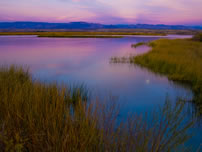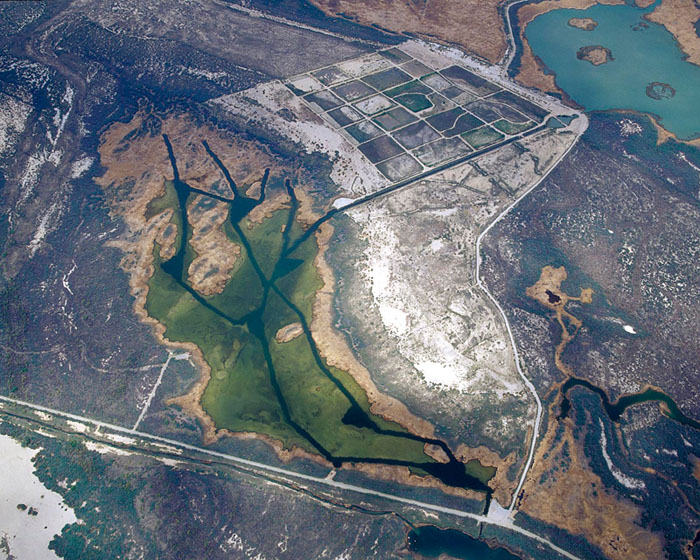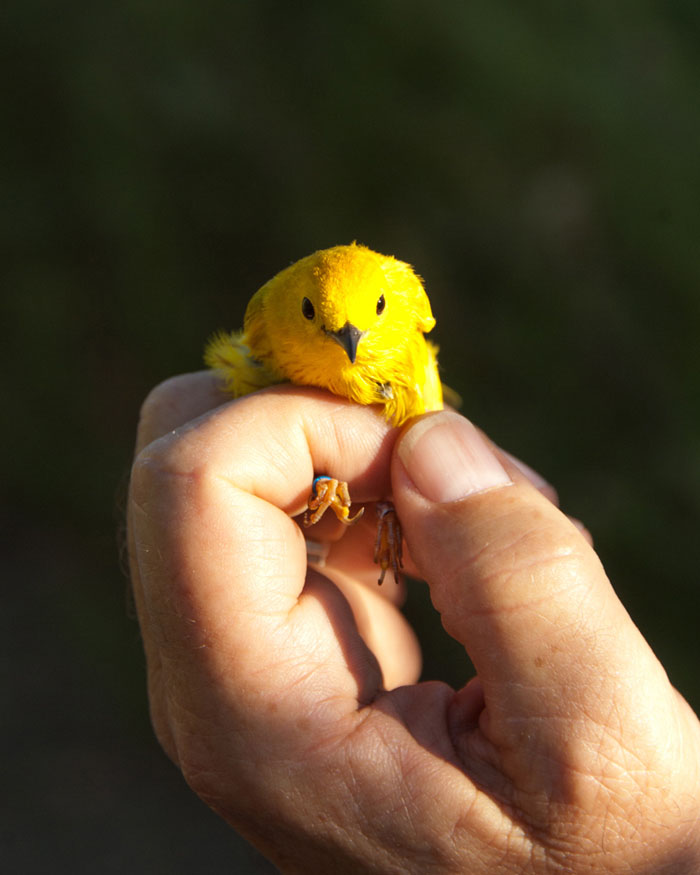



- DESCRIPTION
- LOCATION
- SPECIES USE
- ACTIVITIES
- MULTIMEDIA
Beal Lake Conservation Area began as partnership between the Bureau of Reclamation and the U.S. Fish and Wildlife Service to create a haven for native fish on the Havasu National Wildlife Refuge near Needles, California. In working toward this goal, the partners determined that the project also offered an opportunity for the Lower Colorado River Multi-Species Conservation Program to research efficient ways of using dredged material and test a variety of methods for establishing native plant communities.
In 2001, deep channels were excavated throughout Beal Lake. The excavated sediment was deposited on land adjacent to the lake where the material was mixed with existing soils and divided into a series of fields that could be independently planted, irrigated, and managed. Currently, maintenance dredging began in May 2019 to deepen the existing channels in Beal Lake to a target depth of 12 feet. Dredging operations are anticipated to be completed in September 2020.
The riparian portion of the Conservation Area was developed in two phases. The development of Phase 1 (61 acres) included installation of an irrigation system, soil testing, and demonstration of several planting methods involving native vegetation. During Phase 2 (46 acres), Reclamation prepared additional fields for planting, tested irrigation systems, and demonstrated additional planting techniques, including various seeding methods.
In the winter of 2012, an additional 9 acres of habitat was developed into an area referred to as the Willow Marsh. The acreage was developed with the primary goal of augmenting the quality of habitat at the Beal Riparian site in ways that specifically target the habitat requirements of the Southwestern Willow Flycatcher (SWFL).
Currently, the Beal Lake Conservation Area supports a mosaic of cottonwood, willow, mesquite, marsh habitat types, and continually draws breeding pairs of the Sonoran yellow warblers, Arizona Bell’s vireos, summer tanagers and yellow-billed cuckoos. During the 2012 monitoring season, the conditions available on site attracted a territorial male SWFL, indicating that the site continues to develop into valuable habitat.
A fact sheet for this Conservation Area can be found here. Technical Reports for this Conservation Area can be found here.
Updated January 7, 2020
Beal Lake Conservation Area is located within the Havasu National Wildlife Refuge, which is managed by the U.S. Fish and Wildlife Service. It parallels the Lower Colorado River between river miles 239 and 238. Beal Lake sits adjacent to Topock Marsh, which receives water from the Colorado River. A canal from Topock Marsh supplies water to Beal Lake through a rock structure and wedge wire screen system. Prior to habitat improvement efforts, Beal Lake was a shallow, low-quality aquatic habitat. Along the eastern bank line of Beal Lake sits the riparian restoration area that was originally designed as a research site to demonstrate a variety of planting techniques with native riparian vegetation, but has since developed into a habitat used by several of the LCR MSCP covered species.
The Conservation Area is located on a portion of Havasu National Wildlife Refuge that was and remains closed to the general public which minimizes disruption to wildlife. Information on Havasu National Wildlife Refuge, including location, purpose, and regulations, can be found on their website at this link.
For specific information on the Conservation Area, please contact Terry Murphy, Restoration Group Manager, at (702) 293-8140 or via email at tmurphy@usbr.gov.
The image below shows a close up of the conservation area.
Each Conservation Area targets certain LCR MSCP covered and evaluation species habitats. Below, on the left, is a list of the LCR MSCP species in which habitat will be targeted for creation for this particular conservation area. To the right is a list of LCR MSCP species that, through monitoring, have been found utilizing the conservation area.
| Targeted LCR MSCP Species | LCR MSCP Species Utilizing Site |
| Native Fish | Native Fish |
| Bonytail | Bonytail (stocked) |
| Razorback sucker | Razorback sucker (stocked) |
| Riparian Obligates | Riparian Obligates |
| Arizona Bell's Vireo | Arizona Bell's Vireo (breeding) |
| Elf Owl | |
| Gila Woodpecker | Gila Woodpecker (transient) |
| Gilded Flicker | |
| Sonoran Yellow Warbler | Sonoran Yellow Warbler (breeding) |
| Southwestern Willow Flycatcher | Southwestern Willow Flycatcher (non-breeding resident) |
| Summer Tanager | Summer Tanager (breeding) |
| Vermilion Flycatcher | Vermilion Flycatcher (transient) |
| Yellow-Billed Cuckoo | Yellow-Billed Cuckoo (breeding) |
| Bats, Small Mammals, and Insects | Bats, Small Mammals, and Insects |
| California Leaf-Nosed Bat (foraging) | |
| MacNeill's Sootywing Skipper (breeding) | |
| Townsend's Big-Eared Bat (foraging) | |
| Western Red Bat | Western Red Bat (foraging/roosting) |
| Western Yellow Bat | Western Yellow Bat (foraging/roosting) |
| Colorado River Cotton Rat (resident) | |
| Desert Pocket Mouse (resident, possibly sobrinus subspecies based on range) | |
| Marsh Birds | |
| California Black Rail (transient) | |
| Western Least bittern (breeding) | |
| Yuma Clapper Rail (breeding) | |
| Reptiles | Reptiles |
| Northern Mexican Gartersnake (resident) |
Bird Monitoring
Surveys for covered birds are conducted annually. During the late spring and summer, presence surveys are conducted for birds to document use of the conservation area for nesting, foraging, and migration. Birds monitored include the listed southwestern willow flycatcher and yellow-billed cuckoo, and the following covered species: Arizona Bell’s vireo, Gila woodpecker, gilded flicker, Sonoran yellow warbler, summer tanager and vermilion flycatcher. Surveys have also been conducted in the Beal Lake backwater and other areas with marsh vegetation for California black rail, western least bittern and Yuma clapper rail to see if they are utilizing the conservation area as well.
Mammal Monitoring
Small mammal live trapping is conducted annually to monitor presence of Colorado River cotton rats and desert pocket mice at the conservation area. Bat presence is monitored annually from June through August with remotely recording echolocation calls using a long-term Anabat™ station.
Fisheries
Electro-fishing, larval light trapping, and trammel nets will be accomplished monthly from February through May at locations that are dictated by water level or at locations which have historically produced native fish. Water quality profiles will be performed during each monitoring event and quarterly outside of the monitoring period.
Insect Monitoring
Surveys have been conducted for MacNeill’s sootywing skipper to document presence of the species in the conservation area.
Riparian Management
Irrigation, maintenance, and on-site management for the 116 acres of riparian habitat are ongoing throughout the year. Irrigation typically begins in March and concludes at the end of October.
Acreage Map
This map shows the acreage for this area. You can click on the map for a larger view.
This gallery includes photos of this conservation area. If you require larger photos, please contact our webmaster Michelle Reilly at mreilly@usbr.gov.







